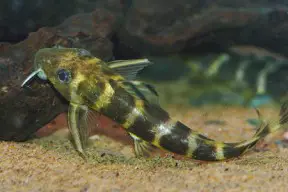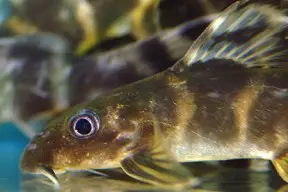Synodontis brichardi
Brichard's Synodontis
Classification
Mochokidae
Distribution
Democratic Republic of Congo, Republic of Congo. It inhabits areas of turbulent water flow, including rapids and highly oxygenated pools below waterfalls.
Habitat
Democratic Republic of Congo, Republic of Congo. It inhabits areas of turbulent water flow, including rapids and highly oxygenated pools below waterfalls.
Maximum Standard Length
6″ (15cm)
Aquarium SizeTop ↑
48″ x 12″ x 12″ (120x30x30cm) – 110 litres.
Maintenance
The aquarium should have a fine gravel or sand substrate and a scattering of smooth rocks of varying sizes. Pieces of driftwood can be used to provide areas of shelter. Water flow should be strong and the water well oxygenated. The use of powerheads is recommended. Plants are not essential, although algal growth should not be discouraged. It will not thrive in aquariums with low water movement.
Water Conditions
Temperature: 72-79°F (22-26°C)
pH: 6.2-7.5
Hardness: 5-20 dH
Diet
Dried foods may be accepted but the ideal diet for S. brichardi is a varied mix of live and frozen foods supplemented with vegetable matter in the form of blanched spinach, shelled peas, cucumber etc. The fish will rasp at these with the teeth on its lower jaw.
Behaviour and CompatibilityTop ↑
A peaceful species but should only be kept with fish that appreciate flowing, oxygenated water. Good tankmates include Steatocranus sp., some Alestiid tetras, Chaetostoma sp., and some of the larger characins and barbs. Should not be kept with territorial species such as other Synodontis.
Sexual Dimorphism
It can be sexed by examining the genital papillae. This is not for the amateur however. The fish should be held ventral side up in the palm of your hand. The dorsal fin should be taken between your middle and ring fingers in order to avoid being pierced by the sharp dorsal fin rays. The genital area you are looking for is concealed beneath the pelvic fins. This can be exposed by pulling (gently) on the caudal fin. A male fish will exhibit an extended papillae which should be pointed and ridged. The spermatoduct can be seen on the caudal side. Females also have a clearly visible papillae but this is more rounded and the oviduct is on the opposite side to the male’s spermatoduct. Most species of medium/large Synodontis can be sexed using this method but it should be noted that most species take 2 years or more to reach sexual maturity.
Reproduction
Not reported to have bred in aquaria, although it has been bred for commercial purposes in Eastern Europe with the aid of hormone injections. They are egg scatterers in the wild.
NotesTop ↑
An unusual and highly adapted species, S. brichardi is one of our favourite Synos and really deserves to be kept in a biotope aquarium to be appreciated at its best. Here, it will be seen moving in and out of areas of high and low current and rasping at algae attached to rocks as in nature. It is much more diurnal than many Synodontis species, if maintained correctly. The colours of this fish intensify with age.



